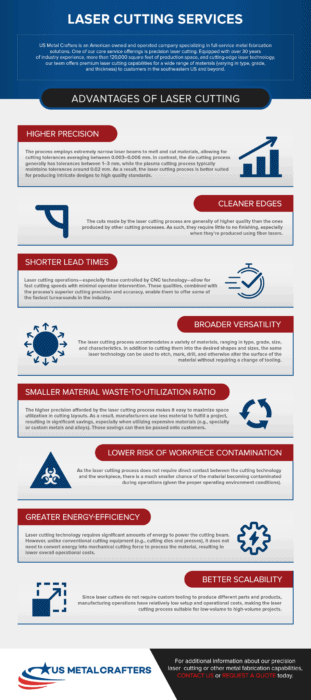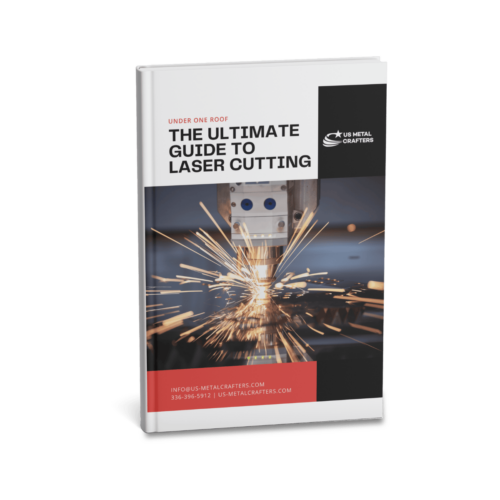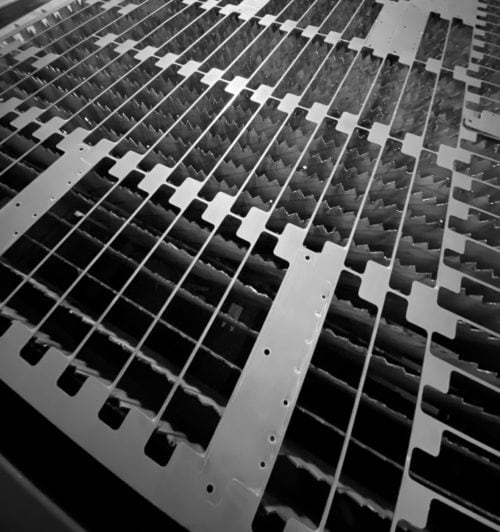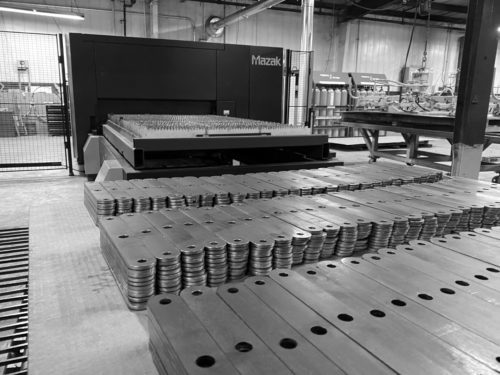Precision Laser Cutting Services
US Metal Crafters is an American-owned and operated company specializing in full-service metal fabrication solutions. One of our core service offerings is precision laser cutting. Equipped with over 30 years of industry experience, more than 120,000 square feet of production space, and cutting-edge laser technology, our team offers premium laser cutting capabilities for a wide range of materials (varying in type, grade, and thickness) to customers in the southeastern US and beyond. Another benefit of working with US Metal Crafters is we run multiple lasers in our shop. Other shops that use a single machine can be down for weeks awaiting repairs if their laser breaks. If we have a laser break, it doesn’t disrupt work because we have more lasers to finish the job.
In the industrial sector, laser cutting serves as a high-precision, high-accuracy manufacturing method for various parts and products, including metal stampings. The process relies on high-powered laser technology to heat, melt, and, ultimately, produce cuts on localized areas of a metal (or other material) workpiece. While laser cutting operations can be manual or automated, they generally employ computerized equipment to guide the path of the laser beam across the material to form the desired design. As such, the components produced tend to have higher tolerances and edge quality than those produced by other manufacturing processes. We can cut from 0.01-1 inch.
In addition to the above benefits, the laser cutting process serves as a superior manufacturing process for many other reasons. The following article outlines the key advantages of the process, as well as the common materials employed in laser cutting operations, the equipment utilized by the US Metal Crafters team, and the typical manufacturing applications for the process.
Advantages of Laser Cutting
As indicated above, the laser cutting process offers numerous advantages over other cutting methods, such as:
- Higher precision. The process employs extremely narrow laser beams to melt and cut materials, allowing for cutting tolerances averaging between 0.003–0.006 mm. In contrast, the die cutting process generally has tolerances between 1–3 mm, while the plasma cutting process typically maintains tolerances around 0.02 mm. As a result, the laser cutting process is better suited for producing intricate designs to high quality standards.
- Cleaner edges. The cuts made by the laser cutting process are generally of higher quality than the ones produced by other cutting processes. As such, they require little to no finishing, especially when they’re produced using fiber lasers.
- Shorter lead times. Laser cutting operations—especially those controlled by CNC technology—allow for fast cutting speeds with minimal operator intervention. These qualities, combined with the process’s superior cutting precision and accuracy, enable them to offer some of the fastest turnarounds in the industry.
- Broader versatility. The laser cutting process accommodates a variety of materials, ranging in type, grade, size, and characteristics. In addition to cutting them into the desired shapes and sizes, the same laser technology can be used to etch, mark, drill, and otherwise alter the surface of the material without requiring a change of tooling.
- Smaller material waste-to-utilization ratio. The higher precision afforded by the laser cutting process makes it easy to maximize space utilization in cutting layouts. As a result, manufacturers use less material to fulfill a project, resulting in significant savings, especially when utilizing expensive materials (e.g., specialty or custom metals and alloys). Those savings can then be passed onto customers.
- Lower risk of workpiece contamination. As the laser cutting process does not require direct contact between the cutting technology and the workpiece, there is a much smaller chance of the material becoming contaminated during operations (given the proper operating environment conditions).
- Greater energy-efficiency. Laser cutting technology requires significant amounts of energy to power the cutting beam. However, unlike conventional cutting equipment (e.g., cutting dies and presses), it does not need to convert energy into mechanical cutting force to process the material, resulting in lower overall operational costs.
- Better scalability. Since laser cutters do not require custom tooling to produce different parts and products, manufacturing operations have relatively low setup and operational costs, making the laser cutting process suitable for low-volume to high-volume projects.
Learn more about Laser Cutting by downloading our free e-book, The Ultimate Guide to Laser Cutting, here.
Common Materials Used in Laser Cutting Operations
One of the key advantages of the laser cutting process is its versatility—i.e., its ability to handle a variety of materials. In industrial manufacturing operations, laser cutters are generally used to process metals. While the term “metals” encompasses a wide range of materials, some of the ones most commonly used in laser cutting are:
- Aluminum. Aluminum is a popular construction material for a variety of industrial components. However, its reflective surface can make processing it with standard laser technology challenging since there is a risk of the laser beam bouncing back. For this reason, manufacturers employ high-powered CO2 or fiber lasers (at least 250 watts) when processing aluminum, as they have the power necessary to pierce through the workpiece and produce a quality cut.
- Brass. Laser cut brass components are used for both functional and decorative applications. The conductivity of the materials make them well-suited for use in electrical and electronic assemblies.
- Stainless steel. Stainless steel is available in several grades—e.g., austenitic stainless steel, duplex stainless steel, ferritic stainless steel, and martensitic stainless steel—each of which offers unique characteristics that make it suitable for different applications. Two of the most common grades are austenitic and ferritic stainless steel, both of which readily accommodate the laser cutting process.
- Mild steel. Mild steel—also referred to as low-carbon steel—is a steel alloy that contains between 0.05–0.25% carbon by weight. Compared to other steel alloys, it is more ductile, machinable, and weldable and less expensive. It is used in the laser cutting operations for both 2D and 3D components.
Types of Laser Cutting Equipment at US Metal Crafters
Laser cutting units can be categorized into one of three classifications based on the state of the active laser medium: gas, liquid, or solid-state. The type employed in a laser cutting operation—and its configuration—varies depending on the part and production specifications.
At US Metal Crafters, we employ two fiber lasers for our laser cutting operations: a Mazak 3000-watt Optiplex Champion 3015 and a Mazak 8000-watt Optiplex Champion 3015. Fiber lasers fall under the solid-state laser category, relying on optical fibers to transmit, amplify, and focus the laser beam during cutting operations. Compared to CO2 lasers (lasers with a gaseous active laser medium), they offer higher precision, better edge finishes, greater energy-efficiency, and faster cutting speeds. Equipped with these two laser cutting units, we can accommodate laser cutting projects involving aluminum, brass, copper, stainless steel, mild steel, and exotic alloys in thickness ranging from 0.01–0.5 in.
In addition to our laser cutting equipment, we maintain a full range of other manufacturing units to support our laser cutting operations. For example, our facility is equipped with a Safan Darley Brake 100-ton premium automatic press brake, which allows us to offer bending services. Other service offerings include grinding, assembly, painting, anodizing, and powder coating.
Applications of Laser Cutting
Some examples of typical laser cut parts and products include brackets (structural or decorative elements used to support other components) and chassis/enclosures (partially or fully enclosed structures used to house electrical and electronic components).
Contact the Laser Cutting Experts at US Metal Crafters Today
Laser cutting offers many manufacturing advantages, including with regard to cutting precision, accuracy, and speed. At US Metal Crafters, we are fully aware of these qualities and how they benefit industrial companies. As such, we offer precision laser cutting services to customers from a wide range of industries—including aerospace, agriculture, furniture, hardware, solar, and more—in the southeastern and other areas of the United States. By partnering with us for their laser cutting needs, they benefit from our:
-
- Extensive industry experience (over 32 years of combined experience)
- Expansive production space (over 120,000 square feet)
- Broad manufacturing capabilities (accommodates simple/complex designs, various metals, and short/long run production volumes)
- Competitive pricing
- Fast lead and delivery times (typical lead times of two to four weeks)
For additional information about our precision laser cutting or other metal fabrication capabilities, CONTACT US or REQUEST A QUOTE today.
Laser Cutting Capabilities
- Mazak 3000 W Fiber Laser
- Mazak 8000 W Fiber Laser
- Programmable, Automatic Press Brake
LASER CUTTING SPECIFICATIONS
| Cutting Axis | 3-Axis |
| Max. Power Output | 8000 W |
| Automation | Sheet Load/Unload |
| Materials | Mild Steel, Stainless Steel, Aluminum |
| Mild Steel Cutting Thickness | Up to 1” |
| Stainless Steel Cutting Thickness | Up to 1″ |
| Aluminum Cutting Thickness | Up to 5/8” |
| Cutting Length | Up to 10’ |
| Cutting Width | Up to 5’ |
| Accuracy | ± .002 |









